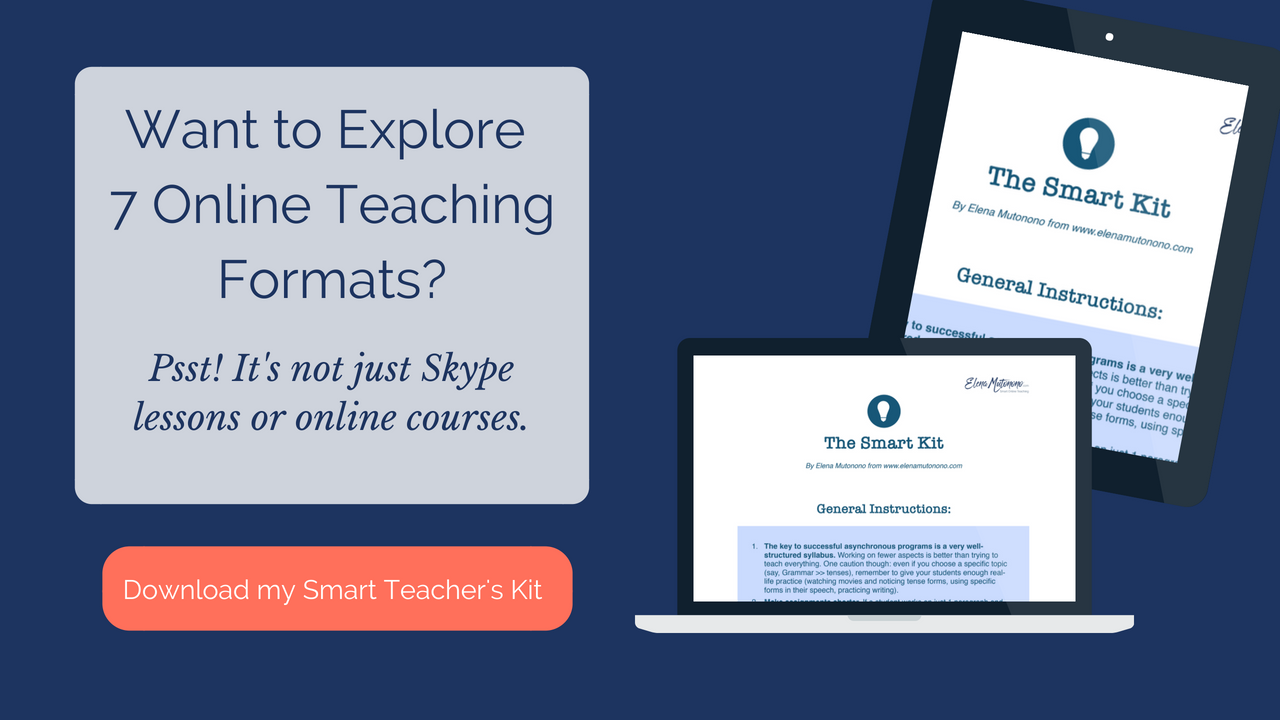One of the things that teacherpreneurs do at the end of the calendar year is revising their products, services, and pricing, as well as vision-casting for the upcoming year. Among many others, price revision can be quite torturous.
- Should I raise my fees or keep them the same?
- Should I raise them for everybody or just for the new clients this year?
In this post I will share some of my experience at setting your fees (including the mistakes, yikes!) and outline some vital principles that have worked for me through the years of teaching English online.
“Why are you charging more than any other language teacher I know?” asked one of my private students a few years ago. “Is that because your rent is high?”
“No, it’s because I value my time and experience so much that I don’t want to just give it away for nothing.”
Pricing: Too Low or Too High?
If you’re only beginning to teach English online, you will find the issue of setting your tuition fees rather challenging. If you go too low, you will most likely recruit a large crowd of people from different walks of life that will quickly fill up your schedule and bring in the revenue you may have originally intended.
However, there will be a huge cost for you to pay, too: high volumes of work, demanding clients (trust me: those who pay little demand more), little time for professional development, little time for preparation and polishing up the quality of your services, almost no time for blogging/writing/designing new materials, and the list goes on.
If you set your fees higher than expected, the thoughts that will bug you are whether or not you are going to make it, whether or not the students will find you and want to buy what you’ve got to offer at your listed price, and will people think that you’re unreasonable?
It is ironic perhaps that in the case of setting your prices too low you tend to please the others and then find yourself in a predicament.
In the case with setting your prices above the average market price, you overcome the fear of negative consequences, but if your sales do go through you will be in a much better shape as a professional language teacher (lots of time on professional development, the energy to design new courses/projects, etc.)
I am not going to advocate for setting your prices too low (lower than the market average) for the reasons I’ve listed in a case study of an online language school in Ukraine.
Why undervaluing your services online will ruin your #brand and desire to #teach #online.Click To Tweet
What happens when you set your fees too low?
I will share though these three main things that setting my fees too low at the beginning of my language tutoring career did for me:
#1: Lots of different students.
I didn’t like that particular group that was demanding, demeaning and disrespectful. They didn’t trust my authority and always argued that there were better ways to teach them. I suffered through that stoically because I somehow told myself that I needed them more than they needed me.
What that situation brought about (apart from lots of unnecessary stress) is I couldn’t focus much on helping the students I did like, giving them the best of my expertise and helping them in their learning process.
#2: Lack of time.
It might surprise you how the students that pay the least will make you slave for the little they’ve paid to get the results that they wouldn’t get anyway (and they will never get the results because they’re actually lazy – there, I said it).
But as you’re trying to dance to their tune and create a pleasant experience for people that can never be pleased with anything, you’re losing one of your most precious assets – your time. You can make more money and you can recruit students, but you will never be able to get back the time that’s been wasted.
#3: Loss of passion.
That’s something everyone goes through, but nothing will help you arrive at this destination sooner and faster than (even a small) bunch of ungrateful students.
When you lose your passion for teaching it’s best to find some time for yourself, but with a whole crowd you’re teaching that is highly unlikely.
5 Value-Based Strategies to Determine Pricing
I may have painted a really gloomy picture for you, but this situation doesn’t hit you hard until you’ve been in it for at least a year or so!
Now think about this for a moment: none of this would have happened, had you set your prices a bit higher and let those demanding students go and find free resources online (or somebody to chat with on social networks for $10 an hour).
So what if we get out of the box and decide to double the average going rate? Unconventional? Maybe. Risky? Sure. Feeling greater responsibility? Wonderful! After all, we probably shouldn’t be teaching unless we’re absolutely sure we’re delivering the best we can. [Speaking of unconventional pricing, check out this post on how Tesla does it]
So, why not? After all, most of us have gadgets that cost us a lot of money, we eat out at expensive restaurants (and pay about 10 times more than the food actually costs at the store), plan some fantastic vacations or even small getaways that are not cheap at all.
Yet we always want to find ways to undervalue ourselves (according to this excellent article I read just a few days ago women tend to undervalue themselves and so one of the tips that the author gives that if you’re a woman entrepreneur make sure you add 30% to the price you want to charge so you’re not too cheap), whether consciously or unconsciously, so here’re some principles I’ve adopted to help me set my tutoring fees.
Struggling to determine pricing of online services? Check out these 5 value-based strategiesClick To Tweet
#1:
Write down all your achievements (set aside your University degree) that make you more competitive than others. Reviewing your resume or putting together a competitive LinkedIn profile might be a great start.
Remember that each achievement speaks of your outstanding personality, your time and money investment. I don’t want to be taught by somebody who hasn’t done any professional development since they graduated from College. Do you? So make sure you list your achievements and know how they make you better than your competition.
#2:
Write down your personality traits that make 1-on-1 learning with you more fun. Your success in business starts with getting to know yourself.
- What makes you different?
- What does your personality give to the student?
- Are you fun and easy-going?
- Are you more on a stricter side, disciplined, and very business-like?
Either set of traits will attract specific kinds of clients to you, as long as you know what it is in you that sets you apart.
Bonus: Veronika Palovska wrote this excellent post on finding your dream client (spoiler alert: for Jane Austen’s fans only).
#3:
Ask yourself: would I like to be taught by somebody like me? Why? List the reasons. One of the reasons I became a teacher (apart from “there’s nothing I can do – it’s in my genes”) is I’ve had good and bad examples in front of me.
I wanted to be like some of my teachers, and I definitely did not want to emulate others. Sometimes a negative example is a strong push for us to form our teaching philosophy (although once formed, it better not be negative!).
Once you look at a teacher through the eyes of a student, you learn to avoid the mistakes that your most negative examples made, and you want to be somebody else, so much so that you even want to be your own teacher. So, it’s a good and honest question: would I want to be taught by me? Then follow up by “Why” and give reasons.
How do you determine the pricing for your online teaching services? Check out this extensive guide.Click To Tweet
#4:
Ask your favorite students why they chose you over other teachers. Note their answers. I wrote more about this very topic in my post on finding your niche, so make sure you do this enlightening exercise!
#5:
Write down how much you are willing to invest into your own professional development annually. Include the courses you’ve taken and how much time and money you’ve put into them.
As a part of my job, I sometimes interview teachers who would like to work for me (incidentally I’ve been running an online language learning platform for Russian speakers – all in Russian).
The first question I ask them is: “Could you list the things you have done in the area of your professional development?” I’ve gotten a number of peculiar answers throughout the years, starting from “I watch movies and read books in English” (or really? So do I! and so do my students!) to “I don’t know what professional development is.”
Granted, those particular teachers I interviewed may have never been trained to think about ongoing professional development (including paid courses) as an integral part of a language teacher’s career.
So, find ways to boost your marketability through ongoing professional development efforts: writing, doing a relevant research, attending conferences and classes.
In Conclusion…
Take your time to finalize your prices and know exactly what you’re offering in return. One of the downsides in the professional pitch of many language teachers is that we don’t quite know what we offer, that is, we might say that we offer language lessons or a language learning software or a book, but we can’t present it as a package.
What do the students pay us for? Is it just the private lessons? How about lesson plans? Worksheets and other materials that you create? Any support that you give outside of your classes? Know what is involved in your providing the learning experience, other than just giving lesson and craft all these experiences into a package.
Learn to summarize what’s in the package in a clear, concise manner so your clients know exactly that what you’re selling is much more than a 45-minute slot.
I hope this information was helpful. I’m sure there are quite a few questions/comments by now. I’d love to hear from you, drop me a line in the comments section or connect with me through other social networks!





 Welcome to my nook where *Big Magic* happens. My name is Elena Mutonono, I help small business owners package their services as digital products and sell them online. I want you to work smarter, not harder. Increase your impact beyond your current face-to-face clients. Grow your business as you reach more people all over the world.
Welcome to my nook where *Big Magic* happens. My name is Elena Mutonono, I help small business owners package their services as digital products and sell them online. I want you to work smarter, not harder. Increase your impact beyond your current face-to-face clients. Grow your business as you reach more people all over the world.








Hi. I love your post!
I am an underpaid, very good online English teacher working for a company as well as a live Math tutor in my city. I’m hoping to offer English classes by myself online next year.
But I’ve really experienced what you said here. I tried doing group classes at an affordable rate, thinking that students will come by the hundreds. But they barely came, cancelled 20 mins. before the time and shunted me around. While my 1on1 clients, who pay me quite well for here in South Africa, come on time and only cancel when something REALLY demands a cancellation. And they don’t have a problem paying what I ask! Literally, no-one complained all year. They realize the value of their children’s education and tutors as professionals.
Now I’m wondering whether I should increase my hourly rate. There is a good chance that I’ll increase it by 6.6%. And I like what you said about professional development. I take that very seriously.
Ruan – I totally understand! As Americans say, “been there, done that.” When you started your budget lessons, did you have a contract in place? For instance, all of my private students receive a contract where it states that if they cancel in less than 24 hours, they lose the lesson. But this is so with private students because it’s easier to reschedule. When you have a group it’s much harder. So demand a payment for a set number of lessons in advance, and if they cancel – they lose the lesson. Also, adjust the price so it’s not too small where the students think, “Well, if it’s only …., I’m not really losing anything.” Even for group lessons there has to be a price adjustment to where you don’t feel like you’re a victim in a situation. Easier said than done, but keep this as a goal.
Adjusting your prices for your current students – that’s good. I might write some about that in the future as well because it’s around this time that teachers are reconsidering contract changes.
Have you tried putting together online courses on udemy for instance? You can put up something short for free and see if that can generate more leads for your business…
hi elana your advice is very useful and inspiring . now I am doing face to face teaching .iam trying to concentrate to enter into online teaching . thanking you
Hey! Thank you for your feedback. Are you doing face-to-face teaching in a one-on-one setting or in a group? One way or another, it’s usually a good way to “get your name out there,” and interact with students, get them to trust you before you decide to switch them from face-to-face format into an online format. We’ve discussed this in the Online Teachers Support Group on linkedin already that in some cases it’s very difficult for people to move from face-to-face instruction into an online classroom, but I remember that first time when I introduced 3-4 of my private students to taking lessons via skype! After a week they didn’t want to go back to face-to-face, they were asking me if they could continue via skype, so keep that in mind for future reference!
As I’ve indicated in Linkedin, which is where I “discovered” Elena, this is possibly the most important thing I’ve read this year. It has set me thinking (a lot) and over the holidays my whole system of teaching administration will change. I’m looking at costs and the use of Google tools in particular. I’m hopeful I get more time to blog myself and produce some YouTube content, this in turn will draw in some quality students who can pay for a good service. See, I have been paying attention. 🙂
Ian, that is very encouraging! I’m sending out an email today to all my students where I offer new packages and prices. Some packages even look more appealing because of the reduced price, but it’s actually a different type of packaging that makes this particular option look like it’s more budget. It will definitely free up my time and rid me of the students who can’t find time to prepare (i.e. I have to backtrack every other lesson, which is extremely annoying), and help those who are willing to work to gain more autonomous learning skills and use me more as a guide, not as the know-it-all person. I’m going to keep all of you updated on how it all goes 🙂
It is really enlightening for a teacherpreneur to take into consideration all the points mentioned in this wonderful, well written article. We should never underestimate our skills and competencies.We should have a strong faith in our abilities to cater to the needs of the learners and in this way can meet our demands as well.
Best wishes to all passionate and dedicated teachers!
Elena, Thank you for this wonderful post. This is a topic that every teacherpreneur will face. I can completely resonate with you. I’ve been through the ups and downs. I’ve learned my lesson and now am brave enough to charge higher. A question for you, do you also raise the price of the students who have been studying with you for a few years or more?
Hey Anne! When I raise prices, I raise them for everyone (actually see the next post to get some creative ideas on how to raise prices). It makes it easier to invoice and doesn’t make me feel like these most faithful students of mine are becoming a burden (because if you don’t raise the prices for them they will eventually become a burden). So to avoid it find ways to offer them a deal that would be compatible in terms of a “price tag,” but will require less of your time (unless they’re willing to pay what you’ve asked them which most of them will). Let’s say you used to charge 1 student $100 for 4 lessons, and then you would want to adjust the rates to where the student will be paying $160 for 4 lessons. You can write to everyone giving them their new prices, then follow up with personal notes to your long-term customers saying, well, I understand that it’s a big jump, and if you can’t pay for the same package it’s alright, you can continue paying $100, and I will give you 2 lessons a month + my e-book + some extra services that I didn’t include in the package before. In my experience some students will say, we’re prepared to pay $160, some will choose 3 lessons a month $120, and those that want to stick to the same price will go with the scenario you offered. You can also give them a small discount if they attend consistently and can pay by a certain date a month. Even if you lose 3-5%, you will gain some more consistent cash flow. I wouldn’t advise though (again, based on my experience and perhaps I’ll write more about it at some point) to create large discounts. I’ve made a mistake like that and now am having to backtrack. My other problem has been from the very beginning is setting different prices for 2 groups of students I was teaching (bad idea), but I started out with a group that was considered “less fortunate” and then switched to a different, paying clientele, and so I wanted to keep both, but could no longer work with those that paid little. So now I’m in this process of weeding this group out by creating different “budget” options for them that will require very little of my time…. It also helps that I work with 3 other teachers, and they don’t mind working for a little less, so I pass those students on to them (but hiring new teachers is tricky as well, see my new post here). But I guess my other piece of advice would be before even setting your prices to think about your perfect client and how much do you see them paying you. Then determine what value you can give them in exchange for that money (think packages, not just “lessons”) and then set the price and stick to it. Thank you for your input!
Hi Elena – like your post. Agree with what you say – we must value ourselves and our time. Loved this one most – our success in business starts with getting to know yourself. I started my consultancy in Learning Strategy and Design a year ago and the introspection and knowing yourself everyday turned out to be the most rewarding aspect of my business – it gave me focus and the ability to explore newer avenues of work. Thanks for sharing your experiences
Sucheta, that is fantastic! One never thinks that getting to know oneself is an essential step to developing something long-lasting and valuable. I’m seeing the changes in my business just because I took the time to think what it is that I want to accomplish with what I do? I think it’s an important starting point for anyone.
I conducted a small survey with my potential students. After seeing their payment options and what i wanted, i created plans and pricing options for different levels of lessons. It seems to work.